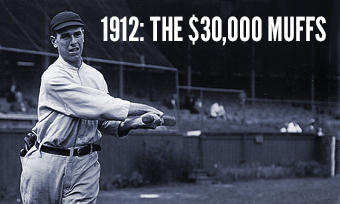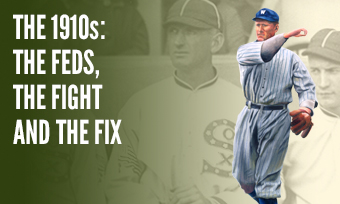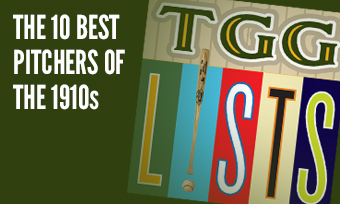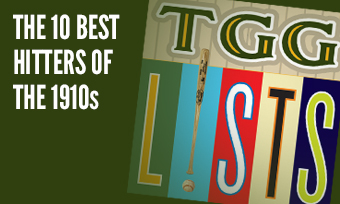The Yearly Reader
Leaders and Honors, 1912
Our list of baseball’s top 10 hitters and pitchers in both the American League and National League for the 1912 baseball season, as well as the awards and honors given to the game’s top achievers of the year.
The National League’s Top 10 Hitters, 1912
Bold type in brick red indicates league leader.
1. Heinie Zimmerman, Chicago
Key Numbers: .372 average, 95 runs, 207 hits, 41 doubles, 14 triples, 14 home runs, 104 RBIs, .571 slugging percentage.
One of those good players with that one great year. Zimmerman was the NL’s first triple crown winner, but then he wasn’t; later research would “officially” strip him of the RBI title. (We still list him as the leader.)
2. Honus Wagner, Pittsburgh
Key Numbers: .324 average, 91 runs, 181 hits, 35 doubles, 20 triples, 7 home runs, 101 RBIs.
This would serve as the epilogue of Wagner’s elite status, even as the NL’s oldest player at age 38; from here he’d give it five more worthy years, but the decline was on.
3. Larry Doyle, New York
Key Numbers: .330 average, 98 runs, 184 hits, 33 doubles, 10 home runs, 90 RBIs, 36 stolen bases.
Doyle’s value was reflected in the fact that he won the short-lived Chalmers Award as the NL’s Most Valuable Player. (Heinie Zimmerman, above, finished seventh in the vote.)
4. Chief Wilson, Pittsburgh
Key Numbers: .300 average, 175 hits, 19 doubles, 36 triples, 11 home runs, 95 RBIs.
In a remarkable effort worthy of Bob Beamon, Wilson hit so many triples in 1912 that they add up to a full 10 more than the guy with the second most ever in one season (see Joe Jackson, below).
5. Bill Sweeney, Boston
Key Numbers: 153 games, .344 average, 204 hits, 31 doubles, 13 triples, 100 RBIs, 68 walks.
Typically a .250 hitter, Sweeney climaxed a two-year spike in which he led the Braves in almost all things offensive; too bad he couldn’t pitch for the team’s woeful staff (101 losses, major league-worst 4.17 ERA).
6. Bob Bescher, Cincinnati
Key Numbers: .281 average, 120 runs, 11 triples, 83 walks, 67 stolen bases.
Bescher led the NL in steals for the fourth straight year; his 120 runs set a career mark.
7. Fred Merkle, New York
Key Numbers: .309 average, 11 home runs, 84 RBIs, 37 stolen bases.
Four years later, Giants fans might still might have found it tough to forgive Merkle for his remarkable blunder that cost the team a pennant, but they were happy for his current-day contributions.
8. Max Carey, Pittsburgh
Key Numbers: .302 average, 114 runs, 45 stolen bases.
As Wagner began to slow, the fleet-footed Carey began to speed up; somehow, his 114 runs would be his last triple-digit production for 10 years.
9. John Titus, Philadelphia-Boston
Key Numbers: .309 average, 99 runs, 32 doubles, 11 triples, 70 RBIs, 82 walks.
The 36-year-old vet, in his last full season, hit .325 after being traded to Boston—but like Bill Sweeney (above), he still couldn’t help the Braves avoid losing 100 games.
10. Sherry Magee, Philadelphia
Key Numbers: .306 average, 25 doubles, 9 triples, 6 six home runs, 66 RBIs, 29 sacrifice hits, 30 stolen bases.
In a relative off-year overall, Magee was anything but off at Baker Bowl—few batters ever were, to be honest—as he batted .361 at the Phillies’ live home yard.
The American League’s Top 10 Hitters, 1912
1. Tris Speaker, Boston
Key Numbers: .383 average, 136 runs, 222 hits, 53 doubles, 12 triples, 10 home runs, 90 RBIs, 82 walks, 52 stolen bases, .464 on-base percentage.
Big year for Spoke; he earned his first of five 50-double seasons, led (or co-led, in this case) the AL in home runs for the only time, had a major league-record three hitting streaks of 20 straight games, and collected his first and only cycle.
2. Ty Cobb, Detroit
Key Numbers: .409 average, 120 runs, 226 hits, 30 doubles, 23 triples, 7 home runs, 83 RBIs, 61 stolen bases, 34 caught stealing, .584 slugging percentage.
A month after his fiery altercation with a handicapped heckler, Ty Cobb was simply on fire—batting .511 with a record 68 hits in July.
3. Joe Jackson, Cleveland
Key Numbers: .395 average, 121 runs, 226 hits, 44 doubles, 26 triples, 90 RBIs.
A prodigious effort for Shoeless Joe, who set a career high in hits and whose 26 triples, while paling alongside Chief Wilson’s 36 above, is still tied for the all-time American League mark.
4. Frank Baker, Philadelphia
Key Numbers: .347 average, 116 runs, 200 hits, 40 doubles, 21 triples, 10 home runs, 130 RBIs, 40 stolen bases.
Arguably “Home Run’s” finest year, setting personal bests in hits, triples, RBIs and average; he accounted for nearly half of the A’s 22 home runs.
5. Eddie Collins, Philadelphia
Key Numbers: .348 average, 137 runs, 189 hits, 11 triples, 101 walks, 63 stolen bases.
Despite one of his most productive years yet, most of Collins’ teammates still hated him for his uppity attitude. With contributions like his, he must have really been rubbing people with all the texture of a cheese grater.
6. Sam Crawford, Detroit
Key Numbers: .325 average, 189 hits, 30 doubles, 21 triples, 109 RBIs, 42 stolen bases.
It only seemed appropriate that the all-time leader in triples would get into the year’s popular three-base act, reaching 20 for the first time in nine years.
7. Clyde Milan, Washington
Key Numbers: .306 average, 105 runs, 11 triples, 79 RBIs, 63 walks, 88 stolen bases.
One look at Milan’s basestealing totals, and it’s easy to understand how he got the nickname Deerfoot.
8. Nap Lajoie, Cleveland
Key Numbers: .368 average, 34 doubles, 90 RBIs.
Despite missing 40 games, Lajoie still managed over 90 RBIs, all without a home run.
9. Larry Gardner, Boston
Key Numbers: .315 average, 88 runs, 24 doubles, 18 triples, 86 RBIs.
The rising star third baseman hit two of his three homers in one day—July 2 at Fenway Park against the New York Highlanders.
10. Stuffy McInnis, Philadelphia
Key Numbers: .327 average, 186 hits, 25 doubles, 13 triples, 101 RBIs.
Though statistically lost in the shadows of bigger talents like Eddie Collins and Home Run Baker, it should be noted that McInnis hit over .300—as he did practically every year of his baseball life.
The National League’s Top 10 Pitchers, 1912
1. Christy Mathewson, New York
Key Numbers: 2.12 ERA, 23 wins, 12 losses, 310 innings, 34 walks.
Mathewson continued to glide in cruise control in the latter stages of his Hall-of-Fame career, but threw no shutouts for the only time.
2. Nap Rucker, Brooklyn
Key Numbers: 2.21 ERA, 18 wins, 21 losses, 6 shutouts, 297.2 innings.
The luckless Rucker undeservedly fell back below .500 as he lost 20 games for the only time in his career.
3. Larry Cheney, Chicago
Key Numbers: 2.85 ERA, 26 wins, 10 losses, 28 complete games, 303.1 innings, 18 wild pitches.
Reinvented as a knuckleballer following a hand injury, Cheney became the latest in an impressive succession of rookies to jump off to a tremendous start to their careers, and gave the Cubs mound relief with Three Finger Brown falling quickly into decline.
4. Claude Hendrix, Pittsburgh
Key Numbers: 2.54 ERA, 24 wins, 9 losses, .727 win percentage, 288.2 innings.
As good as he was on the mound, the spitballing Hendrix was helped out by his defense (league-leading 91 assists) and hitting (.322, six triples in 121 at-bats).
5. Jeff Tesreau, New York
Key Numbers: 1.96 ERA, 17 wins, 7 losses, 243 innings.
Tesreau’s stingy year included a no-hitter, the first thrown by a rookie in modern annals.
6. Hank Robinson, Pittsburgh
Key Numbers: 2.26 ERA, 12 wins, 7 losses.
A rarity in the times in that he pitched more in relief than in the rotation, Robinson was given 16 starts in 1912—and completed 11 of them.
7. Rube Marquard, New York
Key Numbers: 2.57 ERA, 26 wins, 11 losses, 294.2 innings.
Great Rube, not-so-great Rube: 19-0 with a 1.63 ERA through the Fourth of July, 7-11 with a 3.73 ERA afterward.
8. Lew Richie, Chicago
Key Numbers: 2.95 ERA, 16 wins, 8 losses, .667 win percentage, 39 appearances, 27 starts, 15 complete games, 238 innings, 20 grounded into double plays.
Whenever the Cubs played the Giants, there was Richie—given the ball 10 times in 1912 with five wins against New York. After his personal-best win total, a motorcycle accident the following offseason would effectively end his career.
9. George Suggs, Cincinnati
Key Numbers: 2.94 ERA, 19 wins, 16 losses, 42 appearances, 36 starts, 25 complete games, 303 innings, 320 hits allowed, 17 pickoffs.
After a 0-6 July, Suggs rebounded to win 10 games over the season’s final two months; his workload peaked two years in advance of joining the Federal League’s Baltimore Terrapins.
10. Eppa Rixey, Philadelphia
Key Numbers: 2.50 ERA, 10 wins, 10 losses, 23 appearances, 162 innings.
A year after Pete Alexander’s debut, another future Hall of Famer entered the scene for the Phillies as Rixey threw two shutouts within his first five starts on his way to a fine rookie effort.
The American League’s Top 10 Pitchers, 1912
1. Walter Johnson, Washington
Key Numbers: 1.39 ERA, 33 wins, 12 losses, 369 innings, 303 strikeouts.
The Big Train secured his first of five ERA titles and won the most games by an AL pitcher without leading the circuit.
2. Smoky Joe Wood, Boston
Key Numbers: 1.91 ERA, 34 wins, 5 losses, .872 win percentage, 35 complete games, 10 shutouts, 344 innings, 258 strikeouts.
Whereas Johnson would average nearly 30 wins a year through the early 1910s, Wood would struggle just to win 34 more, period, for the remainder of his career after this incredible effort.
3. Ed Walsh, Chicago
Key Numbers: 2.15 ERA, 27 wins, 17 losses, 10 saves, 62 appearances, 41 starts, 393 innings.
In what would be his last year as, virtually, an everyday pitcher before collapsing into immediate decline, Walsh was both the White Sox’ top starter and reliever, leading the majors in games started and saves.
4. Eddie Plank, Philadelphia
Key Numbers: 2.22 ERA, 26 wins, 6 losses, .813 win percentage, 259.2 innings.
In what was surely a satisfying campaign, Plank won more games and lost fewer than any other season through his productive, Hall-of-Fame career.
5. Bob Groom, Washington
Key Numbers: 2.62 ERA, 24 wins, 13 losses, 40 starts, 316 innings.
Three years after losing 15 straight games as a rookie, Groom briefly righted himself and became the Senators’ last 20-game winner (besides Walter Johnson) until 1925.
6. Jack Coombs, Philadelphia
Key Numbers: 3.29 ERA, 21 wins, 10 losses, 262.1 innings.
Another solid effort for the former 30-game winner, before a nasty bout with typhoid fever a year later temporarily derailed his career.
7. Ray Collins, Boston
Key Numbers: 2.53 ERA, 13 wins, 8 losses.
Handicapped with a late start due to a knee injury, Collins caught up and showed that he was just as tough at retiring opponents as Boston’s two 20-game winners and one 30-game winner.
8. Vean Gregg, Cleveland
Key Numbers: 2.59 ERA, 20 wins, 13 losses, 271.1 innings.
A perfect 5-0 September helped ensure Gregg’s second straight 20-win season to begin his big-league career.
9. Chief Bender, Philadelphia
Key Numbers: 2.74 ERA, 13 wins, 8 losses, 27 appearances, 19 starts, 12 complete games, 171 innings, 10 wild pitches, 5 balks.
Another solid year for the Hall of Famer was curtailed as manager Connie Mack suspended him for almost all of September over excessive alcohol use.
10. Buck O’Brien, Boston
Key Numbers: 2.58 ERA, 20 wins, 13 losses, 275.2 innings.
One of baseball’s great one-shot wonders; O’Brien’s 29 career victories are the fewest ever by one with a 20-win season. His clubhouse feuding with Smoky Joe Wood didn’t help his cause to stick around any more than his sudden inability to throw strikes a year later.









